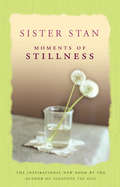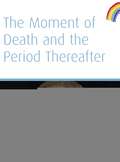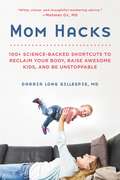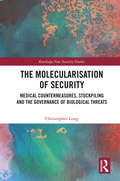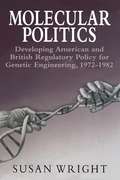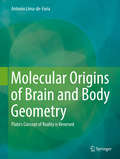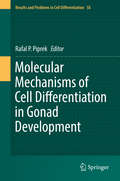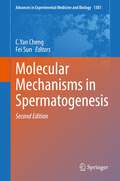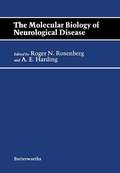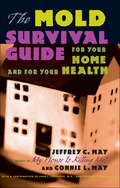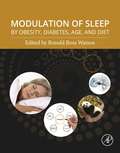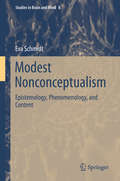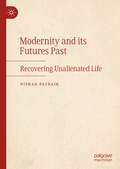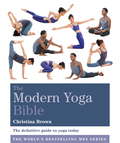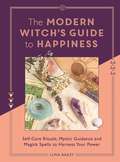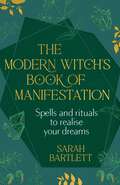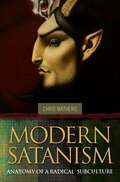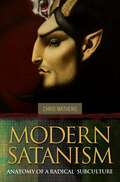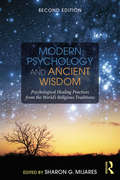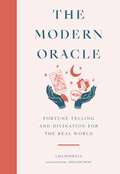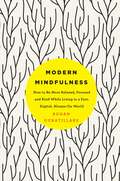- Table View
- List View
Moments of Stillness
by Stanislaus KennedyIn her long-awaited book, Sister Stan draws upon her memories of childhood and the special moments of awareness and mystery which have nourished and enriched her life. As she offers simple reflections to help us focus on the many gifts and blessings that surround us each day, she helps us to connect to our inner world, and the deep, nurturing silence that lies within.
The Moment of Death And The Period Thereafter
by Rudolf SteinerA single lecture taken from the volume Life Beyond Death
Mom Hacks: 100+ Science-Backed Shortcuts to Reclaim Your Body, Raise Awesome Kids, and Be Unstoppable
by Darria Long Gillespie100+ self-care hacks for any mom to eat right, move more, stress less and get a good night's sleep, by a doctor who is also a momWhy is it generally accepted that motherhood comes at the expense of our health--with all that weight gain, fatigue, and exhaustion? It doesn't have to be that way. What if your baby AND you could thrive together? We cure diseases. We create artificial ears using 3-D printers. We solved how to pee in space. We can figure this out--and now Dr. Darria has done just that. An Ivy league-trained physician and mom of two, Dr. Darria combed the latest in medicine, psychology, and holistic health for answers when her own health crises struck. She now brings those solutions to moms everywhere. For moms who just DontHaveTheTime (or energy), Mom Hacks gives you the specific smallest changes that yield the biggest impact for you and your child. Every hack is a mini super-charged solution with an immediate impact. So you feel good, lose the baby weight, and are more present, while raising thriving children--in an entirely do-able, time-saving, with-you-in-the-trenches way. Her humor and personal stories bring warmth and encouragement when mothers need it most. You can be the mother and woman you want to be, and with Mom Hacks, you don't have to listen to anyone who tells you otherwise. It's time for a new mom world order.
Mom Hacks: 100+ Science-Backed Shortcuts to Reclaim Your Body, Raise Awesome Kids, and Be Unstoppable
by Darria Long Gillespie100+ self-care hacks for any mom to eat right, move more, stress less and get a good night's sleep, by a doctor who is also a momWhy is it generally accepted that motherhood comes at the expense of our health--with all that weight gain, fatigue, and exhaustion? It doesn't have to be that way. What if your baby AND you could thrive together? We cure diseases. We create artificial ears using 3-D printers. We solved how to pee in space. We can figure this out--and now Dr. Darria has done just that. An Ivy league-trained physician and mom of two, Dr. Darria combed the latest in medicine, psychology, and holistic health for answers when her own health crises struck. She now brings those solutions to moms everywhere. For moms who just DontHaveTheTime (or energy), Mom Hacks gives you the specific smallest changes that yield the biggest impact for you and your child. Every hack is a mini super-charged solution with an immediate impact. So you feel good, lose the baby weight, and are more present, while raising thriving children--in an entirely do-able, time-saving, with-you-in-the-trenches way. Her humor and personal stories bring warmth and encouragement when mothers need it most. You can be the mother and woman you want to be, and with Mom Hacks, you don't have to listen to anyone who tells you otherwise. It's time for a new mom world order.
The Molecularisation of Security: Medical Countermeasures, Stockpiling and the Governance of Biological Threats (Routledge New Security Studies)
by Christopher LongThis book investigates the way that the molecular sciences are shaping contemporary security practices in relation to the governance of biological threats. In response to biological threats, such as pandemics and bioterrorism, governments around the world have developed a range of new security technologies, called medical countermeasures, to protect their populations. This book argues that the molecular sciences’ influence has been so great that security practices have been molecularised. Focusing on the actions of international organisations and governments in the past two decades, this book identifies two contrasting conceptions of the nature or inherent workings of molecular life as driving this turn. On the one hand, political notions of insecurity have been shaped by the contingent or random nature of molecular life. On the other, the identification of molecular life’s constant biological dynamics supports and makes possible the development and stockpiling of effective medical countermeasures. This study is one of the few to take seriously the conceptual implications that the detailed empirical workings of biotechnology have on security practices today. This book will be of much interest to students of security studies, bio-politics, life sciences, global governance, and International Relations in general.
The Molecularisation of Security: Medical Countermeasures, Stockpiling and the Governance of Biological Threats (Routledge New Security Studies)
by Christopher LongThis book investigates the way that the molecular sciences are shaping contemporary security practices in relation to the governance of biological threats. In response to biological threats, such as pandemics and bioterrorism, governments around the world have developed a range of new security technologies, called medical countermeasures, to protect their populations. This book argues that the molecular sciences’ influence has been so great that security practices have been molecularised. Focusing on the actions of international organisations and governments in the past two decades, this book identifies two contrasting conceptions of the nature or inherent workings of molecular life as driving this turn. On the one hand, political notions of insecurity have been shaped by the contingent or random nature of molecular life. On the other, the identification of molecular life’s constant biological dynamics supports and makes possible the development and stockpiling of effective medical countermeasures. This study is one of the few to take seriously the conceptual implications that the detailed empirical workings of biotechnology have on security practices today. This book will be of much interest to students of security studies, bio-politics, life sciences, global governance, and International Relations in general.
Molecular Politics: Developing American and British Regulatory Policy for Genetic Engineering, 1972-1982
by Susan WrightThe promise of genetic engineering in the early 1970s to profoundly reshape the living world activated a variety of social interests in its future promotion and control. With public safety, gene patents, and the future of genetic research at stake, a wide range of interest groups competed for control over this powerful new technology. In this comparative study of the development of regulatory policy for genetic engineering in the United States and the United Kingdom, Susan Wright analyzes government responses to the struggles among corporations, scientists, universities, trade unions, and public interest groups over regulating this new field. Drawing on archival materials, government records, and interviews with industry executives, politicians, scientists, trade unionists, and others on both sides of the Atlantic, Molecular Politics provides a comprehensive account of a crucial set of policy decisions and explores their implications for the political economy of science. By combining methods from political science and the history of science, Wright advances a provocative interpretation of the evolution of genetic engineering policy and makes a major contribution to science and public policy studies.
Molecular Origins of Brain and Body Geometry: Plato's Concept of Reality is Reversed
by Antonio Lima-de-FariaNew concepts arise in science when apparently unrelated fields of knowledge are put together in a coherent way. The recent results in molecular biology allow to explain the emergence of body patterns in animals that before could not be understood by zoologists.There are no ”fancy curiosities” in nature. Every pattern is a product of a molecular cascade originating in genes and a living organism arises from the collaboration of these genes with the outer physical environment.Tropical fishes are as startling in their colors and geometric circles as peacocks. Tortoises are covered with the most regular triangles, squares and concentric circles that can be green, brown or yellow. Parallel scarlet bands are placed side by side of black ones along the body of snakes. Zebras and giraffes have patterns which are lessons in geometry, with their transversal and longitudinal stripes, their circles and other geometric figures. Monkeys, like the mandrills, have a spectacularly colored face scarlet nose with blue parallel flanges and yellow beard.All this geometry turns out to be highly molecular. The genes are many and have been DNA sequenced. Besides they not only deal with the coloration of the body but with the development of the brain and the embryonic process. A precise scenario of molecular events unravels in the vertebrates.It may seem far-fetched, but the search for the origin of this geometry made it mandatory to study the evolution of matter and the origin of the brain. It turned out that matter from its onset is pervaded by geometry and that the brain is also a prisoner of this ordered construction. Moreover, the brain is capable of altering the body geometry and the geometry of the environment changes the brain.Nothing spectacular occurred when the brain arrived in evolution. Not only it came after the eye, which had already established itself long ago, but it had a modest origin. It started from sensory cells on the skin that later aggregated into clusters of neurons that formed ganglia. It also became evident that pigment cells, that decide the establishment of the body pattern, originate from the same cell population as neurons (the neural crest cells). This is a most revealing result because it throws light on the power that the brain has to rapidly redirect the coloration of the body and to change its pattern.Recent experiments demonstrate how the brain changes the body geometry at will and within seconds, an event that could be hardly conceived earlier. Moreover, this change is not accidental it is related to the surrounding environment and is also used as a mating strategy. Chameleons know how to do it as well as flat fishes and octopuses. No one would have dared to think that the brain had its own geometry. How could the external geometry of solids or other figures of our environment be apprehended by neurons if these had no architecture of their own? Astonishing was that the so called ”simple cells”, in the neurons of the primary visual cortex, responded to a bar of light with an axis of orientation that corresponded to the axis of the cell’s receptive field.We tend to consider our brain a reliable organ. But how reliable is it? From the beginning the brain is obliged to transform reality. Brain imagery involves: form, color, motion and sleep.Unintentionally these results led to unexpected philosophical implications. Plato’s pivotal concept that ”forms” exist independently of the material world is reversed. Atoms have been considered to be imaginary for 2,000 years but at present they can be photographed, one by one, with electron microscopes.The reason why geometry has led the way in this inquiry is due to the fact that where there is geometry there is utter simplicity coupled to rigorous order that underlies the phenomenon where it is recognized. Order allows variation but imposes at the same time a canalization that is patent in what we call evolution.
Molecular Mechanisms of Cell Differentiation in Gonad Development (Results and Problems in Cell Differentiation #58)
by Rafal P. PiprekThis book presents the current state of knowledge on the origin and differentiation of cell lines involved in the development of the vertebrate male and female gonads with particular emphasis on the mouse. It also discusses the processes leading to the testis- and ovary-specific structures and functions.The individual chapters review the origin and differentiation of the somatic cells of the genital ridges; the formation and migration of primordial germ cells in mouse and man; the gonadal supporting cell lineage and mammalian sex determination; differentiation of Sertoli and granulosa cells; mesonephric cell migration into the gonads and vascularization; origin and differentiation of androgen-producing cells in the gonads; germ cell commitment to the oogenic versus spermatogenic pathway and the role of retinoic acid; ovarian folliculogenesis; control of oocyte growth and development by intercellular communication within the follicular niche; biology of the Sertoli cell in the fetal, pubertal and adult mammalian testis; mechanisms regulating spermatogonial differentiation; stem cells in mammalian gonads; the role of microRNAs in cell differentiation during gonad development; human sex development and its disorders; as well as methods for the study of gonadal development.
Molecular Mechanisms in Spermatogenesis (Advances in Experimental Medicine and Biology #1288)
by C. Yan Cheng Fei SunThis new edition provides an update on the molecular mechanisms that regulate spermatogenesis. In addition to the rodent as a study model, chapters also include research on studies in humans. It includes the latest approaches of studying spermatogenesis, such as the use of bioinformatics, molecular modeling and others which are not commonly found in published materials. It also reviews the latest developments in the field, such as studies on the role of regulatory RNAs on spermatogenesis. Due to the declining fertility rate among men, a brand new chapter highlights the impact of environmental toxicants on spermatogenesis.
The Molecular Biology of Neurological Disease: Butterworths International Medical Reviews
by Roger N. Rosenberg A. E. HardingThe Molecular Biology of Neurological Disease reviews advances that have been made in understanding the molecular mechanisms of neurological disorders as well as immediate and future applications of molecular biological techniques to clinical practice. This book explores the molecular genetics of neurological disease such as muscular dystrophy, Joseph disease, and Huntington's disease, along with the mitochondrial genes implicated in such conditions. This text is comprised of 18 chapters and begins by introducing the reader to the basic principles and methods of molecular genetic techniques used in the diagnosis of neurological disease. Attention then turns to several aspects of genetic expression in the brain, including the extent to which the genome is expressed in the brain. The next chapter focuses on the visualization of polyadenylated messenger RNAs in individual cells in mammalian brain using in situ hybridization techniques, combined with immunohistochemical localization of specific proteins and neuropeptides implicated in diseases such as Alzheimer dementia. This book also discusses the molecular biology of chemical synaptic neurotransmission; proteins involved in the regulation of nervous system development; and gene expression in skeletal muscle. This text then concludes with a summary of the ""neurological gene map"" as it stands in the latter part of 1987. This book is intended for physicians who grapple with the problems of neurological disorders on a daily basis, including neurologists, neurologists in training, and those in related fields such as neurosurgery, internal medicine, psychiatry, and rehabilitation medicine.
The Mold Survival Guide: For Your Home and for Your Health
by Jeffrey C. May Connie L. MayThe image was shocking: a couple wearing protective suits and masks in their own home! The accompanying USA Weekend story documented the mold-related headaches, fatigue, and respiratory problems that forced Melinda Ballard and Ron Allison to abandon their dream house, leaving all their possessions behind. Another family was so terrified that they had their mold-filled house torn down.Mold growth threatens property managers and builders, as well as home owners and renters. Legal settlements in some mold cases have reached the millions, and home insurance rates are skyrocketing. Some people argue that mold concerns are exaggerated; others are convinced that mold growth is destroying their health.In The Mold Survival Guide, a prominent indoor air quality professional teams up with a writing specialist to describe mold, to explain where and why it flourishes in homes, and to offer advice on how to eradicate mold while minimizing health risks. The book includes a chapter by two physicians who explain how exposure to mold can affect health.With clear scientific explanations and expert advice, The Mold Survival Guide is a valuable resource for anyone worried about a common household problem that can have serious consequences.
Modulation of Sleep by Obesity, Diabetes, Age, and Diet
by Ronald Ross WatsonSleep disorder is a rampant problem in the US, with over 40 million Americans currently diagnosed according to the NIH. There is a clear association between sleep disorder and a wide range of other human disorders –performance deficiencies, psychiatric illnesses, heart disease, obesity and more – but in spite of this there is not yet a convenient overview on the market detailing the impact of obesity, age, diabetes and diet on sleep duration and attendant health outcomes. This volume focuses on the interaction between sleep and these factors, with special attention being paid to the potential for neurological modulation of sleep via diet. The volume aid readers in understanding the role each of these factors plays in sleep architecture and its regulation by circadian biology and neurology. Aids in understanding the impact of age, diet, obesity and disease on sleepOffers focus on neurological changes that affect metabolismExplores diabetes induced sleep problemsAid to understanding the multifactorial causes of age-related sleep dysfunctionAddresses selected studies of nutraceuticals affecting sleep for potential application clinicallyDiscusses major impact on sleep disorders by caffeine and alcohol
Modest Nonconceptualism: Epistemology, Phenomenology, and Content (Studies in Brain and Mind #8)
by Eva SchmidtThe author defends nonconceptualism, the claim that perceptual experience is nonconceptual and has nonconceptual content. Continuing the heated and complex debate surrounding this topic over the past two decades, she offers a sustained defense of a novel version of the view, Modest Nonconceptualism, and provides a systematic overview of some of the central controversies in the debate.An explication of the notion of nonconceptual content and a distinction between nonconceptualist views of different strengths starts off the volume, then the author goes on to defend participants in the debate over nonconceptual content against the allegation that their failure to distinguish between a state view and a content view of (non)conceptualism leads to fatal problems for their views. Next, she makes a case for nonconceptualism by refining some of the central arguments for the view, such as the arguments from fineness of grain, from contradictory contents, from animal and infant perception, and from concept acquisition. Then, two central objections against nonconceptualism are rebutted in a novel way: the epistemological objection and the objection from objectivity.Modest Nonconceptualism allows for perceptual experiences to involve some conceptual elements. It emphasizes the relevance of concept employment for an understanding of conceptual and nonconceptual mental states and identifies the nonconceptual content of experience with scenario content. It insists on the possibility of genuine content-bearing perceptual experience without concept possession and is thus in line with the Autonomy Thesis. Finally, it includes an account of perceptual justification that relies on the external contents of experience and belief, yet is compatible with epistemological internalism.
Modernity and its Futures Past: Recovering Unalienated Life
by Nishad PatnaikThe work reimagines emancipatory possibilities in the face of reified capitalist modernity. The enlightenment resulted in a ‘disenchanted’ world, stripped of ‘anthropomorphised’ meaning and purpose. This world, in its capitalistic figuration, alienates us from others, and from nature. To rearticulate emancipatory possibilities requires a non-alienated relation to society and nature. Yet, modernist disenchantment cannot be undone by returning to pre-modern ‘enchantment’. Rather, such rearticulation calls for the recovery of ‘unalienated life’ from within non-reified modernity, by renewing its universalist dimension.
The Modern Yoga Bible: Cong Chu Xue Dao Gao Shou = The Modern Yoga Bible (Godsfield Bibles)
by Christina BrownYoga brings not only a suppleness to the body but also a sense of well-being to those who practise it. Featuring over 350 postures from the main schools of yoga, The Modern Yoga Bible is the ultimate step-by-step guide to active flowing sequences, slower, more restorative floor-based postures (yin-yoga) and meditation. From luscious limbering to blissful backbends, this book offers beginners and expert yogis alike tips to on how to deepen their practice and modify poses to suit their individual needs and experiences. Learn to utilise body, energy and mind to find a yoga philosophy tailored to modern life.
The Modern Witch's Guide to Happiness: Self-care rituals, mystic guidance and magick spells to harness your power
by Luna BaileyIt’s time to give your inner witch a voice. Unlock the magick of modern witchcraft and infuse your every day with happiness. This is your essential spiritual guide to happiness. Including everything you need to know to become a modern witch, from working with tarot cards and healing crystals, to taking direction from the stars, this book will teach you how to harness the power of the natural world, dispel toxic energy and develop your own psychic ability to find happiness. Illustrated throughout and containing simple yet effective practical tips and tricks, self-care rituals and cleansing spells for the everyday, this treasure chest of a book will empower you to live your life to the fullest. Summon your inner goddess, re-connect with yourself and take control of your happiness.
The Modern Witch’s Book of Manifestation: Spells and rituals to realise your dreams
by Sarah BartlettThe art of manifestation is not only about connecting to the universe to help you to achieve an outcome, but also about self-understanding, self-discovery and truly believing in your desires and intentions. Manifesting your goals and dreams is about making the things you want to happen, well, happen. By drawing on Wiccan wisdom, you will amplify and enhance all aspects of realising those desires.This book shows you how to connect to your inner witch, cultivate confidence, self-belief, awareness and how to set powerful intentions. It also tells you the secret magic of the numbers 3,6, 9, and their use in manifestation techniques. This book also explains what manifestation is and isn't, and it teaches you all the basics of Wicca, such as how to work with solar and lunar cycles, deities, symbols and the five magical elements, create a sacred space and a 'book of shadows' to empower and amplify your intentions and manifestations. Along with a variety of Wiccan rituals and spell-casting, you will discover how to conjure positivity to attract the results you seek.
A Modern Way to Cook: Over 150 Quick, Smart And Flavour-packed Recipes For Every Day
by Anna JonesFrom the author of the brilliant A Modern Way to Eat, a new collection of delicious, healthy, inspiring vegetarian recipes – that are so quick to make they’re achievable on any night of the week.
Modern Satanism: Anatomy of a Radical Subculture
by Chris MathewsIn 1966, Anton LaVey introduced to the world the Church of Satan, an atheistic religion devoted to the philosophy of individualism and pitilessness often associated with Satan. Modern Satanism offers a comprehensive survey and analysis of the church that LaVey built. Satanism has been an open religion for forty years now and operates successfully in its self-created countercultural niche. Given the provocative nature of its name, contemporary Satanism is only superficially understood as an alternative religion/ideology, and all-too-frequently seen as a medieval superstition and associated with rumors of obscure rituals, perverse hedonism, cult-like behavior, and tales of ritual abuse and murder. These may be misconceptions, but the truth behind the unenviable reputation is no less dramatic. Satanism generally eschews supernatural beliefs and embodies a staunchly individualistic, pitiless, anti-egalitarian creed. If there is anything fundamentally diabolical about modern Satanism, it stems more from the echoes of Nazism in its theories than from its horror-comic trappings.Modern Satanism covers the history, ideology, personalities, and practices of the decentralized international movement that contemporary Satanism has become. The work addresses the various beliefs and practices espoused by those who follow it: the ideal of Satan as a rebellious emblem; Satanism's occult, literary, and philosophical influences; the history of the Church of Satan and other Satanic organizations; the ideology of Satanism; Satanism's frequent flirtations and strong parallels with neo-Nazism and other forms of extremism; Satanism in the media and popular culture; and the reasons for Satanism's continuing attractiveness to new converts. Though the tone of the work attempts to remain neutral when discussing historical matters, it is by necessity critical of the subculture's extremist rhetoric and recurring associations with the far right and racialist extremism.
Modern Satanism: Anatomy of a Radical Subculture
by Chris MathewsIn 1966, Anton LaVey introduced to the world the Church of Satan, an atheistic religion devoted to the philosophy of individualism and pitilessness often associated with Satan. Modern Satanism offers a comprehensive survey and analysis of the church that LaVey built. Satanism has been an open religion for forty years now and operates successfully in its self-created countercultural niche. Given the provocative nature of its name, contemporary Satanism is only superficially understood as an alternative religion/ideology, and all-too-frequently seen as a medieval superstition and associated with rumors of obscure rituals, perverse hedonism, cult-like behavior, and tales of ritual abuse and murder. These may be misconceptions, but the truth behind the unenviable reputation is no less dramatic. Satanism generally eschews supernatural beliefs and embodies a staunchly individualistic, pitiless, anti-egalitarian creed. If there is anything fundamentally diabolical about modern Satanism, it stems more from the echoes of Nazism in its theories than from its horror-comic trappings.Modern Satanism covers the history, ideology, personalities, and practices of the decentralized international movement that contemporary Satanism has become. The work addresses the various beliefs and practices espoused by those who follow it: the ideal of Satan as a rebellious emblem; Satanism's occult, literary, and philosophical influences; the history of the Church of Satan and other Satanic organizations; the ideology of Satanism; Satanism's frequent flirtations and strong parallels with neo-Nazism and other forms of extremism; Satanism in the media and popular culture; and the reasons for Satanism's continuing attractiveness to new converts. Though the tone of the work attempts to remain neutral when discussing historical matters, it is by necessity critical of the subculture's extremist rhetoric and recurring associations with the far right and racialist extremism.
Modern Psychology and Ancient Wisdom: Psychological Healing Practices from the World's Religious Traditions
by Sharon G. MijaresModern Psychology and Ancient Wisdom, 2nd edition, brings together experts who explore the use of ancient healing techniques from Buddhism, Christianity, Goddess, Shamanism, Taoism, and Yogic traditions as well as the mystical practices of Judaism and Islam and their application to modern counseling and therapy professions. Each chapter lays out time-tested techniques used by teachers, guides, and practitioners to facilitate psychological healing, embraces a wide variety of cultural perspectives, and offers a large, varied, and meaningful view of the world. This new edition includes added material on Islam, indigenous, and shamanic healing perspectives and practices, as well as new findings in the fields of neuropsychology and epigenetics. With its vast offerings of new treatment methods from a variety of perspectives—from therapeutic metaphors and breathing exercises to meditation and yoga techniques—this book will be of use to mental health professionals, social workers, and pastoral caregivers.
Modern Psychology and Ancient Wisdom: Psychological Healing Practices from the World's Religious Traditions
by Sharon G. MijaresModern Psychology and Ancient Wisdom, 2nd edition, brings together experts who explore the use of ancient healing techniques from Buddhism, Christianity, Goddess, Shamanism, Taoism, and Yogic traditions as well as the mystical practices of Judaism and Islam and their application to modern counseling and therapy professions. Each chapter lays out time-tested techniques used by teachers, guides, and practitioners to facilitate psychological healing, embraces a wide variety of cultural perspectives, and offers a large, varied, and meaningful view of the world. This new edition includes added material on Islam, indigenous, and shamanic healing perspectives and practices, as well as new findings in the fields of neuropsychology and epigenetics. With its vast offerings of new treatment methods from a variety of perspectives—from therapeutic metaphors and breathing exercises to meditation and yoga techniques—this book will be of use to mental health professionals, social workers, and pastoral caregivers.
The Modern Oracle: Fortune Telling and Divination for the Real World
by Lisa BoswellDiscover your fortune, change your destiny.Use your star sign to reach your fitness goals, kickstart your career with crystal energy, sort out of your love life with tarot or embark on some deep self-reflection with palmistry.With expert guidance from a Romany-Gypsy psychic and diviner, The Modern Oracle will teach you the key methods of fortune telling and divination, helping you answer life's big questions and solve everyday dramas.Find out what your future holds.'Psychic mediums are the new wellness coaches' - NY Times
Modern Mindfulness: How to Be More Relaxed, Focused, and Kind While Living in a Fast, Digital, Always-On World
by Rohan GunatillakePreviously published as This is HappeningRohan Gunatillake, creator of the best-selling buddhify app, argues that to lead more mindful, calm and happy lives, switching off is the last thing we need to do. Instead he gives you the ideas, principles and techniques to bring awareness, composure and kindness to wherever you are and whatever you are doing. Filled with over sixty practical exercises which you can plug into your life straight away, the mobile mindfulness approach of Modern Mindfulness presents a way to get the benefits from meditation however busy your life is.
